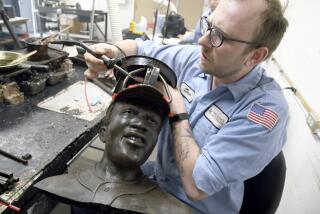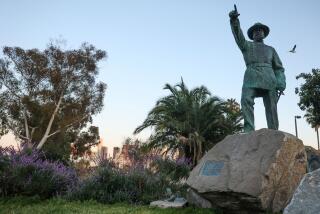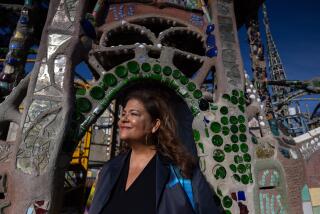His Former Kingdom for a Parking Spot
RIGA, Latvia — The conqueror stands conquered in a parking lot.
A bronze czar on a bronze horse, Peter the Great sits impassive and severe in his dominion of Audis, Volkswagens and Zhiguli sedans behind a real estate company on a side street in Riga. An admirer has planted pansies at his feet.
It is a testament to the czar, who swept murderously into Latvia in 1701 in his quest to open Russia to the sea, that three centuries later his monument inspires passion, and even obsession, here in this Baltic capital that is Russia no more.
The statue has been sunk to the bottom of the Baltic Sea, guarded by the Soviet army, desecrated by the Latvian army, fought over by politicians and sneaked through Riga’s streets in the dead of night.
And the odyssey is not over yet. This year, Latvian leaders will decide whether to release the monument from its asphalt exile and put it back on public display. But where? What plaza is the appropriate place to honor the man who conquered their country?
In the end, the saga of the statue is a story of how nations define themselves by their heroes, and how small nations may spend lifetimes stepping out of the shadows of former rulers.
“You know, it amazes me why 3 1/2 tons of bronze should create such havoc,” said Eugene Gomberg, a businessman who spent five years and $200,000 restoring the statue. “But I talked to a historian once. And her observation was that Latvia as a country is sort of creating its history. And this history is supposed to be victorious.
“She said what I was doing with this statue was deconstructing their history.”
Russian-speaking Latvians such as Gomberg make up about a third of Latvia’s population, and in the 13 years since Latvia declared independence from the former Soviet Union, disputes over language and political rights have divided its citizens. The split seems to run as deep as history.
Many ethnic Russians view Peter the Great as a beneficent conqueror whose bloody Northern War “liberated” Latvia, which was then part of Livonia, from the Swedes. Peter I is celebrated in Russia as the czar who traveled incognito to Europe, studied shipbuilding and European culture, then returned to build in backward Russia the elegant European capital of St. Petersburg.
But the same ruler’s three-month siege of Riga killed more than 60,000 people through war, starvation and disease -- not exactly cause for celebration, many Latvians say.
Perhaps, said Ojars Sparitis, head of Riga’s monuments committee, Latvia might emulate neighboring Lithuania, which put all its old Soviet-era statues of Lenin, Stalin and Dzerzhinsky in a single park, surrounded by barbed wire and watchtowers. Officially, it is called the Exposition of Soviet Sculptures, but locals call it Stalin World.
“Their relics are exhibited in an amusement park, like Disneyland,” Sparitis said. “When a country thinks it can amuse itself with history, it must be strong. In Latvia, history is still a bitter element which cannot be dismissed by smiling. Because the history is still too close.”
Maria Petrovskaya, who spends most spring mornings selling lilies of the valley at the towering Freedom Monument -- on the canal embankment where the statue of Peter the Great once stood -- said she saw no reason to bring it back from its parking lot domain.
“Peter was of course a good czar,” she said. “But he was good for Russia. He opened the sea for Russia, not for us. We Latvians already had the sea.”
Peter’s monument stood only five years in Riga’s central square, where it was erected in 1910. By 1915, when even church bells were being melted down in preparation for war, the statue was loaded on a ship bound for St. Petersburg. But the Serbino was torpedoed by a German submarine.
Estonian divers who explored the wreck several years later found the statue covered with algae. They blasted it apart, hauled it in pieces up to the surface and sold it back to Latvia.
Still in pieces, the statue arrived back in Riga in 1934. But by then, there was nowhere to put it -- the Freedom Monument was going up where Peter had stood. The bronze horseman was consigned to a warehouse.
In 1988, Stanislav Razumovsky, an ethnic Russian engineer at a military construction company, saw a photo of the statue.
“From that day, my life changed completely,” said Razumovsky, 59, the son of a former art museum director. “I couldn’t sleep that night.... Something in my soul told me that now I was on a mission. On a mission to save the ruined monument to this great man from oblivion.”
He quit his job. He learned where the statue was being stored, and after digging around for more than an hour in a pile of rusty metal, he found the breast and head of a horse. Behind a ventilation pipe in a corner was an arm. Then several more pieces emerged.
Razumovsky persuaded a Soviet army unit to take charge of the statue in a military warehouse, except the head, which he took home to the small apartment he shared with his mother.
Every day, Razumovsky drove out to the warehouse. He began trying to screw the pieces of the statue together himself with long brass bolts. But over the years, several parts of it had simply disappeared.
By now it was 1993, and the Soviet army was making its last retreat from Latvia, handing over the warehouse to the new Latvian army. Razumovsky told the new commander that he was in the midst of restoring the statue, but he was sent away and told not to return.
In despair, Razumovsky said, he circled the perimeter of the base like a wolf whose mate was caught in a trap. A few days later, peering through a crack in the fence, he caught a glimpse of his treasure. It was ringed with broken beer bottles, and both legs had been torn off.
He began to fear that someone would come and seize the statue’s head from his apartment. He settled on a plan.
He put the head in the biggest backpack he could find, loaded it in his car and parked near the Russian Embassy, eyeing the Latvian guard outside. “Finally, I saw my chance. The door was open while some people were going out, and I ran as fast as I could. The policeman saw me and ran toward me. His hand was already reaching for me when I jumped in, seconds before the door closed.”
Leonid Budakov, who was the duty officer that day, remembers it vividly. “A man runs into the embassy who’s all agitated, very nervous, with his hair standing on end, with a big backpack,” he recalled recently.
“I asked him to open the backpack. Naturally, it contained the head of Peter the Great.”
With the head safely ensconced in the basement of the embassy, Razumovsky continued to fret about the rest of the monument. Prodded by the Russian government, the city kept talking of plans to restore it but never came up with the money or a specific plan. That’s when Gomberg entered the picture.
With Riga’s 800th anniversary celebrations approaching in August 2001, Gomberg hatched a plan to erect the monument in a park not far from its original setting. But the proposal ran into opposition from Latvian conservatives, who regarded the statue as a piece of history the country would be better off forgetting.
“What would this monument symbolize?” said Janis Birks, head of the Fatherland and Freedom faction, which led opposition to plans for the statue. “Peter the Great is elevated over the city with his horse, which means he’s the victor. Right at the moment when we were joining the European Union and NATO, this would be a symbol of Russia.”
Six months before the anniversary celebration, the opponents came up with a plan to offer the statue to St. Petersburg, in honor of that city’s 300th anniversary in 2003.
Gomberg was aghast. “It was absolutely evident to everyone that it was an attempt to get rid of the statue,” he said.
The Russian Foreign Ministry urged St. Petersburg to refuse the gift. But St. Petersburg balked -- it had its own powerful politicians, including some of President Vladimir V. Putin’s senior staff, and it wanted the statue badly. True, St. Petersburg already had more than its share of Peter the Great monuments; but why, many St. Petersburg officials wondered, should Russians leave this one in Riga to be insulted?
The Kremlin finally weighed in, ordering a polite refusal of Latvia’s offer. Vladimir Churov, then deputy chairman of St. Petersburg’s external affairs committee, proposed an alternative: The city, he said, would be happy to accept a replica of the statue.
That meant the original Peter could have his day in the sun in Riga. Gomberg received an offer from the Riga port to display the statue in its spacious downtown park. Mayor Gundars Bojars signed off for the issue “to be processed,” and politics being what they were, Gomberg took that as a go-ahead.
Just after midnight on Aug. 17, 2001, Gomberg loaded the huge monument onto a truck, drove it through downtown Riga and placed it in the port park. He covered it with a large white parachute, planning an official unveiling later.
By the time Gomberg returned the next morning, the cover was already gone. Many people had placed flowers on the monument. One man arrived with a basket of eggs and threw one at Peter the Great’s face. Another took the rest of the basket and upturned it on the first man’s head.
Gomberg stood and gazed at his statue. “It just looked excellent. Magnificent, shining, brand-new,” he said.
He saw Razumovsky, who also couldn’t drag himself away. “People would come and go, but I would stay there for hours, looking at my most beautiful Peter,” the engineer said later. “It was the best moment of my entire life.”
But it was short-lived. The conservatives were enraged. Riga’s vice mayor called Gomberg and told him to “get rid of it,” no matter how. The statue was hauled to the parking lot behind Gomberg’s office, where it has remained, awaiting the designation of a final display site.
As for St. Petersburg’s replica, things didn’t go smoothly there, either. Gomberg was arrested by St. Petersburg authorities last year for absconding with the plaster molds for the statue from a foundry in a dispute over whether the city would pay him for them. Both sides backed off, and the replica was completed in time for the gala 300th anniversary celebrations last July. Now a statue of Peter the Great stands outside Konstantin Palace, the residence of Russia’s president when he is in St. Petersburg. It looks remarkably like a princely statue that stands in the back of a parking lot in a small neighboring land -- a country that once was part of Russia and now is not.
Times staff writer Sergei L. Loiko contributed to this report.
More to Read
Sign up for Essential California
The most important California stories and recommendations in your inbox every morning.
You may occasionally receive promotional content from the Los Angeles Times.










